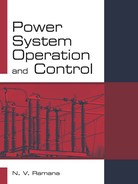1.1 INTRODUCTION
The problem of economic operation of a power system or optimal power flow (OPF) can be stated as:
Allocation of the load (MW) among the various units of generating station and among the various generating stations in such a way that, the overall cost of generation for the given load demand is minimum.
This is an optimization problem, the objective of which is to minimize the power generation cost function subject to the satisfaction of a given set of equality and inequality constraints. The problem is analyzed, solved and then implemented under online condition of the power system. The input data for the problem comes from conventional power flow study. For a given load demand, power flow study can be used to calculate of active and reactive power generations, line flows and losses. The study also furnishes some control parameters such as the magnitude of voltage and voltage phase differences. The economic scheduling problem can be understood as an outcome of multiple power flow studies, where a particular power flow study result is considered more appropriate in terms of cost of generation. The solution to this problem cannot be optimal unless otherwise all the constraints of the system are satisfied. We discuss the economic scheduling problem in the following sections, but first we consider the constraints that need to be addressed.
The problem of economic operation of the power system involves two sub-problems, namely, unit commitment (UC) and economic dispatch (ED). While UC is an off-line problem, ED is an area of online concern. The result of UC is an initial solution of the ED problem.
1.1.1 Unit Commitment Problem
Generally the load curve of a plant where there is a variation of load vs time in a season, follows a particular trend or pattern. Hence these curves can be predicted with minimum degree of error. Let N be the number of generating units available in a plant. The problem of UC is to forecast how the plant load should be allocated amongst the N units in such a way that the overall cost of generation of the plant is minimum. In other words, the solution of UC for N available units is a schedule of the units that must be kept in ‘on’ (committed) condition or in ‘off’ (decommitted) condition. The problem of UC is complex, since a large number of constraints such as start-up and shut-down costs and times, fuel cost per KWh, minimum and maximum generating capacities need to be addressed.
1.1.2 Economic Dispatch Problem
In contrast to the UC problem, ED assumes that N number of units in the different generating stations are already committed or in ‘on’ condition. The problem here is to forecast how the load should be shared amongst them in such a way that the overall cost of generation is minimum. The solution to UC is the starting point of the ED problem. That is, once a decision on the units that are to be committed is taken, then ED resolves the distribution of load amongst the committed units. If all the units are in ‘on’ condition, UC does not exist and we have to take up only the ED problem. Since UC is beyond the scope of this chapter, let us focus our discussion on the economic dispatch problem for the following case studies.

This chapter deals with Case 1 while the following two chapters present the other two case studies.
